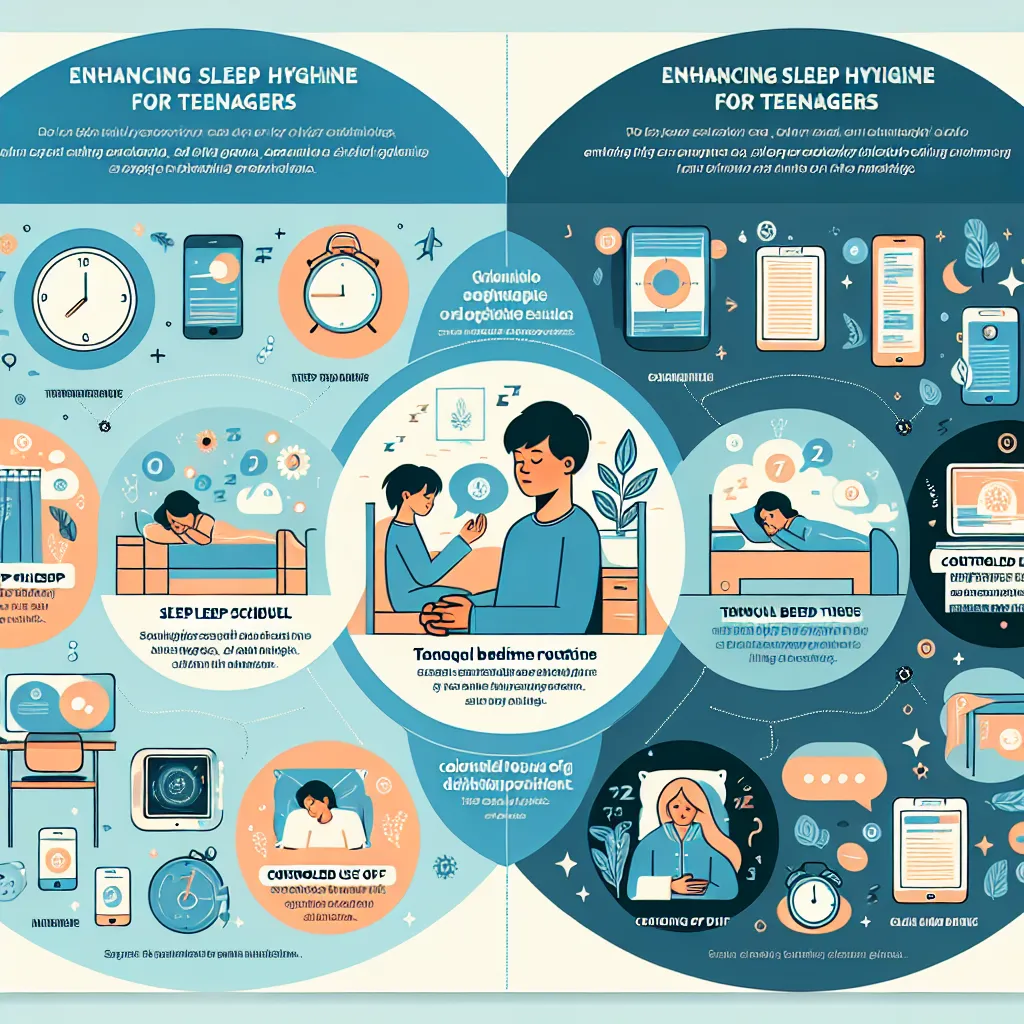The IELTS Reading section is a crucial component of the test, assessing your ability to comprehend complex texts and extract relevant information. Today, we’ll focus on a topic that has become increasingly important in recent years: strategies for improving sleep hygiene in teenagers. This subject has appeared in various forms in past IELTS exams and, given its relevance to modern society, is likely to resurface in future tests.
Based on our analysis of past IELTS Reading passages, topics related to teenage health and well-being, particularly sleep habits, have been featured regularly. The growing concern over adolescent sleep deprivation and its impact on academic performance and overall health makes this subject highly relevant for IELTS test-takers.
Let’s dive into a sample IELTS Reading passage on this topic, followed by questions and a detailed analysis to help you improve your Reading skills.
IELTS Reading Sample Passage
The Sleep Crisis Among Teenagers
A. In recent years, sleep researchers and health professionals have raised alarm bells about what they call a “sleep crisis” among teenagers. This crisis is characterized by widespread sleep deprivation and poor sleep quality, which can have serious consequences for adolescents’ physical health, mental well-being, and academic performance. The problem is so pervasive that some experts are calling it a public health epidemic.
B. The root causes of this sleep crisis are multifaceted. One significant factor is the biological shift in circadian rhythms that occurs during puberty. As teenagers develop, their bodies naturally begin to secrete melatonin—the hormone responsible for regulating sleep—later in the evening. This shift can make it difficult for teens to fall asleep before 11 p.m., even when they try to go to bed earlier. Unfortunately, this biological change conflicts with early school start times, leading to a chronic sleep deficit for many adolescents.
C. Another major contributor to poor sleep hygiene among teenagers is the ubiquitous presence of electronic devices in their lives. Smartphones, tablets, and computers emit blue light, which can suppress melatonin production and disrupt natural sleep patterns. Moreover, the engaging nature of social media, online gaming, and streaming services can lead to what sleep experts call “bedtime procrastination,” where teens delay sleep in favor of digital activities.
D. The consequences of chronic sleep deprivation in teenagers are far-reaching. Lack of adequate sleep has been linked to increased risk of obesity, diabetes, and cardiovascular problems. It can also exacerbate mental health issues such as anxiety and depression. In the academic realm, sleep-deprived students often struggle with attention, memory consolidation, and problem-solving skills, leading to poorer grades and standardized test scores.
E. Recognizing the severity of this issue, sleep experts and health organizations have begun to advocate for strategies to improve sleep hygiene among teenagers. One of the most widely supported measures is delaying school start times. Several studies have shown that pushing back the first bell by even 30 minutes can lead to significant improvements in students’ sleep duration, attendance rates, and academic performance.
F. On an individual level, experts recommend establishing a consistent sleep schedule, even on weekends. This helps regulate the body’s internal clock and can make it easier to fall asleep and wake up at appropriate times. Creating a relaxing bedtime routine—such as reading a book, practicing gentle yoga, or listening to calming music—can also signal to the body that it’s time to wind down.
G. Managing technology use is another crucial aspect of improving sleep hygiene. Setting a “digital curfew” at least an hour before bedtime can help reduce exposure to sleep-disrupting blue light. Some experts suggest removing all electronic devices from the bedroom to eliminate the temptation of late-night scrolling or gaming. For those who must use devices in the evening, blue light filtering apps or glasses can help mitigate the negative effects on sleep.
H. Lifestyle factors also play a role in sleep quality. Regular exercise can improve sleep, but vigorous activity too close to bedtime can be stimulating. Nutritionists advise avoiding caffeine in the afternoon and evening, as its effects can last for several hours. Similarly, heavy meals close to bedtime can disrupt sleep, so a lighter evening meal is preferable.
I. While these strategies can be effective, implementing them often requires a concerted effort from teenagers, parents, and educational institutions. Some schools have begun incorporating sleep education into their health curricula, teaching students about the importance of good sleep hygiene and providing practical tips for improvement. Parents can support these efforts by modeling good sleep habits and helping to create a home environment conducive to healthy sleep.
J. As awareness of the teenage sleep crisis grows, so does the impetus for change. By implementing evidence-based strategies to improve sleep hygiene, we can help ensure that the next generation of young adults is well-rested, healthy, and ready to face the challenges of the modern world. The path to better sleep may not be easy, but the potential benefits—for individuals and society as a whole—make it a journey worth undertaking.
 Teenage sleep hygiene infographic
Teenage sleep hygiene infographic
Questions
1-5: Matching Headings
Choose the correct heading for paragraphs A-E from the list of headings below.
List of Headings:
i. The biological basis of teenage sleep patterns
ii. A multifaceted problem affecting adolescents
iii. The role of technology in disrupting sleep
iv. Potential solutions from educational institutions
v. The wide-ranging impacts of sleep deprivation
vi. Changing school schedules to accommodate teen sleep needs
vii. The importance of consistent sleep routines
A. Paragraph A –
B. Paragraph B –
C. Paragraph C –
D. Paragraph D –
E. Paragraph E – ____
6-10: True/False/Not Given
Do the following statements agree with the information given in the reading passage?
Write
TRUE if the statement agrees with the information
FALSE if the statement contradicts the information
NOT GIVEN if there is no information on this
-
Melatonin production in teenagers naturally occurs earlier in the evening compared to adults. ____
-
Blue light from electronic devices can suppress melatonin production. ____
-
All schools in the United States have delayed their start times to improve student sleep. ____
-
Exercising too close to bedtime can make it harder to fall asleep. ____
-
Sleep education is now a mandatory part of all school health curricula. ____
11-13: Sentence Completion
Complete the sentences below. Choose NO MORE THAN THREE WORDS from the passage for each answer.
-
Teens often engage in “bedtime procrastination” by using __ instead of sleeping.
-
Creating a __ can help signal to the body that it’s time to sleep.
-
Some experts recommend removing __ from the bedroom to avoid temptation.
Answer Key and Explanations
-
A – ii (A multifaceted problem affecting adolescents)
Explanation: Paragraph A introduces the “sleep crisis” among teenagers as a widespread issue with multiple consequences, indicating a multifaceted problem. -
B – i (The biological basis of teenage sleep patterns)
Explanation: Paragraph B discusses the biological shift in circadian rhythms during puberty, explaining the natural changes in teenage sleep patterns. -
C – iii (The role of technology in disrupting sleep)
Explanation: Paragraph C focuses on how electronic devices and their use contribute to poor sleep hygiene among teenagers. -
D – v (The wide-ranging impacts of sleep deprivation)
Explanation: Paragraph D outlines various consequences of chronic sleep deprivation in teenagers, including physical, mental, and academic impacts. -
E – vi (Changing school schedules to accommodate teen sleep needs)
Explanation: Paragraph E discusses the strategy of delaying school start times to improve teenagers’ sleep duration and academic performance. -
FALSE
Explanation: The passage states that during puberty, teenagers’ bodies begin to secrete melatonin later in the evening, not earlier. -
TRUE
Explanation: The passage directly states that blue light from electronic devices can suppress melatonin production. -
NOT GIVEN
Explanation: While the passage mentions that delaying school start times is a recommended strategy, it doesn’t state that all U.S. schools have implemented this change. -
TRUE
Explanation: Paragraph H mentions that vigorous activity too close to bedtime can be stimulating, implying it can make it harder to fall asleep. -
NOT GIVEN
Explanation: The passage mentions that some schools have incorporated sleep education, but it doesn’t state that it’s mandatory in all schools. -
digital activities
Explanation: The passage states that teens delay sleep in favor of “digital activities.” -
relaxing bedtime routine
Explanation: Paragraph F mentions creating a “relaxing bedtime routine” to signal to the body that it’s time to wind down. -
all electronic devices
Explanation: Paragraph G suggests “removing all electronic devices” from the bedroom to eliminate temptation.
Common Mistakes to Avoid
-
Misinterpreting “Not Given” answers: Remember, “Not Given” means the information is neither confirmed nor denied in the text. Don’t assume information based on your own knowledge.
-
Falling for distractors: In multiple-choice questions, incorrect options often contain words from the text. Always read the full context carefully.
-
Overlooking synonyms: IELTS often uses synonyms or paraphrases. Train yourself to recognize different ways of expressing the same idea.
-
Time management: Don’t spend too much time on difficult questions. If stuck, move on and return later if time allows.
-
Ignoring instructions: Pay close attention to word limits in sentence completion tasks. Exceeding the word limit will result in a wrong answer.
Key Vocabulary
-
Circadian rhythms (noun) – /sərˈkeɪdiən ˈrɪðəmz/ – the physical, mental, and behavioral changes that follow a 24-hour cycle
-
Melatonin (noun) – /ˌmeləˈtoʊnɪn/ – a hormone that regulates the sleep-wake cycle
-
Sleep hygiene (noun) – /sliːp ˈhaɪdʒiːn/ – habits and practices conducive to sleeping well on a regular basis
-
Ubiquitous (adjective) – /juːˈbɪkwɪtəs/ – present, appearing, or found everywhere
-
Exacerbate (verb) – /ɪɡˈzæsərbeɪt/ – make (a problem, bad situation, or negative feeling) worse
-
Procrastination (noun) – /prəˌkræstɪˈneɪʃən/ – the action of delaying or postponing something
-
Conducive (adjective) – /kənˈduːsɪv/ – making a certain situation or outcome likely or possible
Grammar Focus
Pay attention to the use of conditional sentences in the passage, particularly in discussing potential solutions:
“If teenagers implement these strategies, they may see improvements in their sleep quality.”
This is an example of a first conditional sentence, used to talk about real and possible situations in the future. The structure is:
If + present simple, will/can/may + infinitive
Practice forming similar sentences related to the topic:
- If schools delay start times, students will likely get more sleep.
- Teenagers can improve their sleep hygiene if they establish a consistent bedtime routine.
- If parents model good sleep habits, their children may develop better sleep practices.
Tips for IELTS Reading Success
-
Practice active reading: Engage with the text by underlining key points and making mental notes as you read.
-
Improve your vocabulary: Regularly learn new words and their synonyms to better understand complex texts.
-
Develop your skimming and scanning skills: Practice quickly identifying main ideas and locating specific information.
-
Read a variety of texts: Expose yourself to different topics and writing styles to prepare for the diverse content in IELTS.
-
Time management: Practice completing reading tasks within the allocated time to improve your speed and efficiency.
-
Analyze your mistakes: After practice tests, carefully review your errors to understand your weak areas and focus your study efforts.
Remember, consistent practice and a strategic approach are key to improving your IELTS Reading score. Good luck with your preparation!


